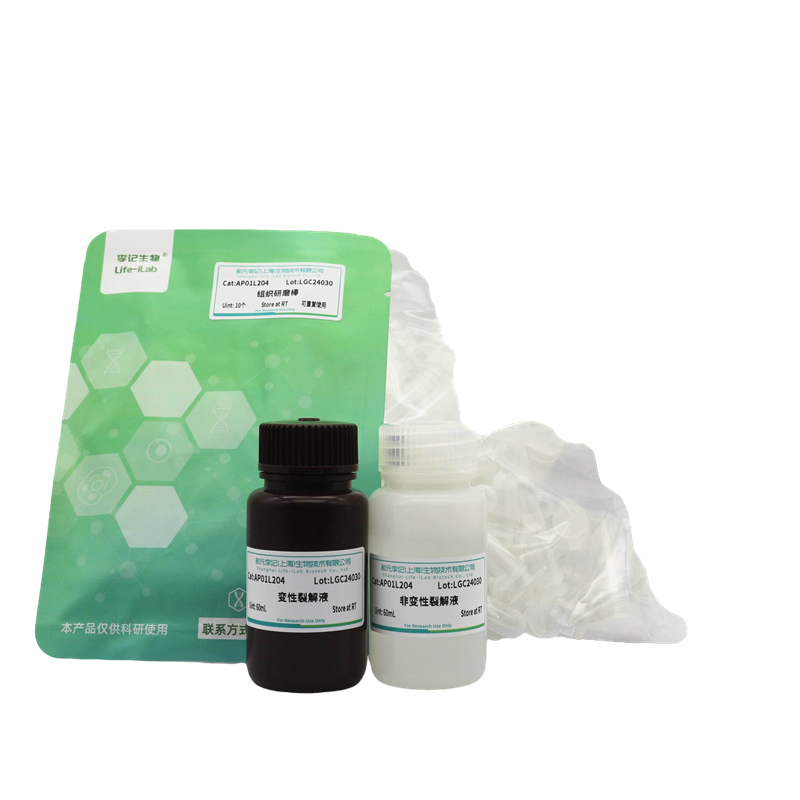Product Description
This kit innovatively adopts a column purification method, which can quickly, gently, and efficiently lyse animal tissues or cells, effectively extract total proteins, including centrifuge columns and optimized cell lysate. Compared with traditional RIPA lysis buffer, this kit can extract more proteins, avoiding partial protein loss caused by DNA precipitation and insoluble cell debris during cell lysis. By using column purification technology, a minimum of 20 μ L of sample and lysate mixture can be processed, and a maximum of 500 μ L. We provide two types of cell lysates: denatured and non denatured. Users can choose different lysates according to their subsequent experimental needs.
[Note]: Denaturated lysate can be used for SDS-PAGE, Western blotting, ELISA analysis; Non denaturing lysate can be used for analysis of IP, Co IP, enzyme assays, etc.
ordering information
Product Name | Item number | Specifications |
Column animal tissue/cell total protein extraction kit | AP01L204 | 100T |
Product components
Product components | Specifications(100T) | Storage temperature |
Denatured lysate | 60mL | 4℃ |
Non denaturing lysate | 60mL | 4℃ |
Protein extraction centrifuge column | 100个 | RT |
Organizational grinding rod | 10个 | RT |
Product advantages
1. Quick: The extraction process only takes 2 minutes and does not require ice operation.
2. Simplicity: Only simple centrifugation is required, no ultrasound is needed.
3. Universal: Suitable for all types of animal cells and tissues.
4. Efficient: No protein loss, especially suitable for the extraction of small molecule proteins, membrane proteins, nucleic acid binding proteins, and phosphorylated proteins.
Transportation and storage
Transport at room temperature. Denaturated lysis buffer is stored at room temperature, while non denatured lysis buffer is stored at 4 ℃, with a shelf life of 12 months. [Note]: The grinding rod can be reused. At low temperatures, component precipitation may occur in the denatured cracking solution, which can be slowed down to room temperature or in a water bath.
usage method
Cell samples
1、 Sample cracking
Denaturation fluid extraction
1. Remove the cell culture medium and wash twice with pre cooled PBS. Add 150-200uL of lysis buffer evenly to each well of the 6-well plate. If
Excessive cell density can increase the amount of lysis buffer to 250-300uL. 【 Note 】: Insufficient lysis buffer can result in incomplete cell lysis and affect the quality of protein extraction.
2. Blow several times with a gun and transfer the lysate to the centrifuge column. [Note]: A small amount of cells that have not been lysed does not affect the quality of the final protein extraction.
Centrifuge at
3. 14000 rpm for 1 minute.
4. Collect the lysate at the bottom of the centrifuge tube, which is the cell protein extract. [Note]: The cell lysate does not contain protease inhibitors, and users need to add protease inhibitors
The preparation prevents protein degradation.
Non denaturing liquid extraction
1. Remove the cell culture medium and wash twice with pre cooled PBS. Add 150-200uL of lysis buffer evenly to each well of the 6-well plate. If
Excessive cell density can increase the amount of lysis buffer to 250-300uL. 【 Note 】: Insufficient lysis buffer can result in incomplete cell lysis and affect the quality of protein extraction.
2. Blow with a gun several times, place on ice for 10 minutes, and then transfer the lysate to a centrifuge column.
Centrifuge at
3. 14000 rpm for 1 minute.
4. Collect the lysate at the bottom of the centrifuge tube, which is the cell protein extract. [Note]: The cell lysate does not contain protease inhibitors, and users need to add protease inhibitors
The preparation prevents protein degradation.
2、 Suspended cells
Denaturation fluid extraction
1. Collect cells 0.5~2 × 107
Wash twice with 1mL pre cooled PBS in a 1.5mL centrifuge tube, centrifuge at 1000xg for 3 minutes, discard the supernatant, and repeat three times.
2. Add the same volume of pre cooled PBS to resuspend the cells according to the volume of cell precipitation, and then add the corresponding amount of denatured lysis buffer according to the cell volume. [Note]: The table shows recommendations
consumption; PBS should not be added excessively, as long as it can resuspend the cells.
Cell precipitation volume(uL) | Add volume of cracking solution(uL) |
3 | 20 |
5 | 50 |
10 | 150 |
20 | 250 |
40 | 500 |
3. After 15 seconds of vigorous shaking, transfer the lysate to a centrifuge column. [Note]: A small amount of cells that have not been lysed does not affect the quality of the final protein extraction.
4. Centrifuge at 14000 rpm for 1 minute (if the lysate is too viscous, the centrifugation time can be increased).
5. Collect the lysate at the bottom of the centrifuge tube, which is the cell protein extract. [Note]: The cell lysate does not contain protease inhibitors, and users need to add protease inhibitors
The preparation prevents protein degradation.
Non denaturing liquid extraction
1. Collect cells 0.5~2 × 107
Wash twice with 1mL pre cooled PBS in a 1.5mL centrifuge tube, centrifuge at 1000xg for 3 minutes, discard the supernatant, and repeat three times.
2. Add the corresponding amount of non denaturing lysis buffer according to the cell volume. [Note]: The recommended dosage is shown in the table.
Cell precipitation volume (uL) added to lysis buffer volume (uL)
Cell precipitation volume (uL) | Add lysis buffer volume (uL) |
3 | 20 |
5 | 50 |
10 | 150 |
20 | 250 |
30 | 500 |
40 | 500 |
3. After 15 seconds of vigorous shaking, incubate on ice for 10 minutes.
4. Transfer the lysate to the centrifuge column.
5. Centrifuge at 14000 rpm for 1 minute
6. Collect the lysate at the bottom of the centrifuge tube to obtain the cell protein extract. [Note]: The cell lysate does not contain protease inhibitors, and users need to add protease inhibitors
The preparation prevents protein degradation.
3. Organize samples
Denaturation fluid extraction
1. Cut the organization into small pieces.
2. Add appropriate lysis buffer, usually 100mg of tissue is added to 1mL of lysis buffer. [Note]: If the cracking is not sufficient, the cracking solution can be appropriately increased.
3. Use a grinding rod to grind the tissue in a 1.5mL centrifuge tube or use a glass homogenizer until fully lysed. [Note]: If it is difficult to grind the myocardium, skin, etc
Organizations should use homogenizers for homogenization.
4. Transfer the lysate to the centrifuge column.
5. Centrifuge at 14000 rpm for 1 minute (if the lysate is too viscous, the centrifugation time can be increased).
6. Collect the lysate at the bottom of the centrifuge tube to obtain the whole protein extract. [Note]: If the tissue sample is very small, it can be directly added to the lysis buffer after shearing and vigorously vortexed
splitting.
Non denaturing liquid extraction
1. Cut the organization into small pieces.
2. Add appropriate lysis buffer, usually 100mg of tissue is added to 1ml of lysis buffer. [Note]: If the cracking is not sufficient, the cracking solution can be appropriately increased.
3. Grind the homogenizer with a grinding rod until fully lysed. Leave it on ice for 10 minutes. [Note]: For tissues such as myocardium and skin that are not easily ground, they should be
Use a homogenizer to homogenize.
4. Transfer the lysate to the centrifuge column.
5. Centrifuge at 14000 rpm for 1 minute.
6. Collect the lysate at the bottom of the centrifuge tube to obtain the whole protein extract. [Note]: If the tissue sample is very small, it can be directly added to the lysis buffer after shearing and vigorously vortexed
splitting.
matters needing attention
1. This product is only for scientific experimental research and should not be used in clinical diagnosis, treatment, or other fields.
2. This product does not contain protease inhibitors. During use, a mixture of protease inhibitors (100 x, without EDTA) (item number: AP02L084) should be added to prevent protein degradation.
3. This product is not compatible with the Bradford method for measuring protein concentration. Please use the BCA protein quantification kit (item number: AP12L025).
This product is only for scientific experimental research and should not be used in clinical diagnosis, treatment, or other fields.














 Back
Back
 Back
Back




























